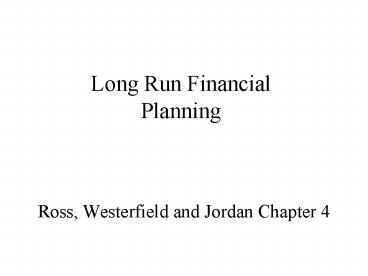Long Run Financial Planning - PowerPoint PPT Presentation
1 / 15
Title:
Long Run Financial Planning
Description:
Unlike many financial economics topics, the reasoning used ... As an implication, dividends are the 'leftovers' Note also that RDP policy may not be feasible ... – PowerPoint PPT presentation
Number of Views:81
Avg rating:3.0/5.0
Title: Long Run Financial Planning
1
Ross, Westerfield and Jordan Chapter 4
- Long Run Financial Planning
2
Teaching Notes This material in this lecture
borders accounting rather than economics. The
number crunching and what if analysis we do is
of immense practical importance for our
students. Unlike many financial economics
topics, the reasoning used relies very little on
invisible hand arguments. A significant part
of our class meeting (not reflected in these
notes) is spent retrieving corporate balance
sheets from the web, and interpreting them in
light of 1) past operating performance, 2)
expected future operating performance and 3)
personal preferences of the actors involved. The
class discussion is supplemented by an in-class
worksheet that reinforces and extends Examples 1
and 2 in the lecture notes.
3
Long-Term Financial Planning
- Develop projected income and balance sheet
statements. - Percentage of sales approach simply assume that
many variables are a fixed percentage of sales. - Assets, COGS, NWC, etc.
- Less reasonable for long-term borrowing and
equity - Sales growth forecasts are then key.
4
Assume that sales grow by 10, forecast next
years balance sheet.
5
Lets Redo the Balance Sheet
- Problem Assets must grow, so liabilities must
also grow. - But this involves choices. There is no correct
way to forecast the balance sheet without knowing
our financial goals. - Approach Forecast all variables except one.
- That variable is called the plug.
6
Example 1
- Forecast the balance sheet on the previous slides
under the following assumptions - Case I
- Keep nominal debt level constant
- Use retained earnings to finance growth in assets
- If earnings exceed investment capital needed, pay
out a dividend - Case II
- Do not pay dividends.
- Use retained earnings to finance growth in assets
- If earnings exceed investment capital needed, pay
down debt
7
Residual Dividend Policy
- As the firm grows
- Fully fund all positive NPV projects
- Keep D/E constant
- Do not issue equity (Why? Higher fees,
signaling, etc.) - As an implication, dividends are the leftovers
- Note also that RDP policy may not be feasible
8
Residual Dividend Policy Example
- A firm expects 1000 in earnings over the course
of the next year. - They prefer a D/E ratio of ½.
- They expect 900 in Capex will be needed over the
course of the year. - How much debt will they have to issue?
- How much will dividends be?
9
Example 2
- Redo the problem with expected Capex of 1200 and
with 1800. - General fact We expect firms with more
investment opportunities to pay less in dividends
and cash cow firms to pay more.
10
Maximal growth rate?
- Assuming status quo payout policy
- Case I No external financed will be used.
- Case II Assume that debt may be issued, but only
enough to keep a stable D/E ratio.
11
Financial Planning GoalsOther Possibilities
- Keep a stable payout ratio, or
- Avoid dividend cuts.
- which means that you may be very cautious with
dividend policy. - If earnings jump, you do not respond with a
commensurate jump in dividends. - Dividends are stable but creep up over time.
- Lets see what firms actually do
www.finance.yahoo.com
12
Sticky Dividends
- Standard deviation of year-over-year change in
13
A compromise policy many firms appear to follow
- Do not cut back on positive NPV projects simply
to avoid a cut in dividends - In the short-run, try to avoid dividend cuts and
equity issuance - Cash holdings and new debt issues are the plug
- In the long-run, try to maintain a target D/E
ratio and try to avoid equity issuance. - Dividends are the plug.
14
(No Transcript)
15
SP 500 dividend yield































